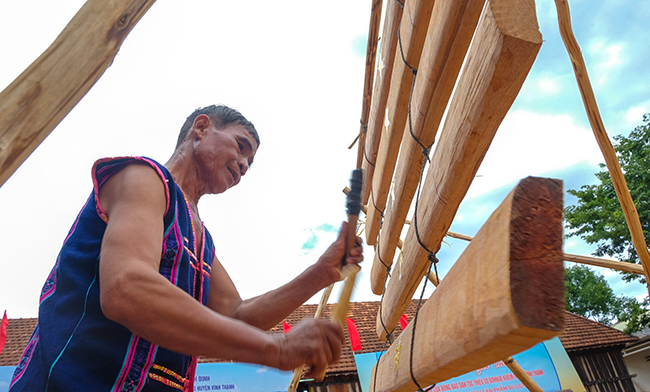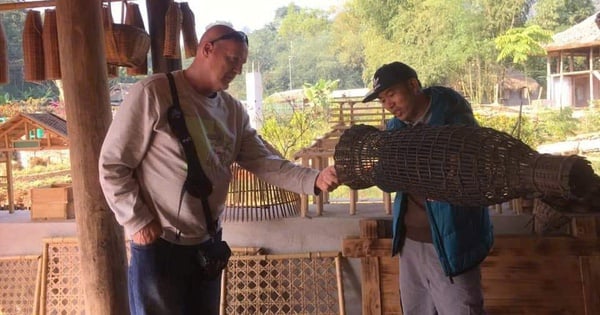The sound of the zither resonates
Along with gongs and some other musical instruments, the Po Lon Khon is often used by the Bana people in the province to play in orchestras. Considered to be an instrument that appeared early in the cultural and spiritual life of the Bana people, the Po Lon Khon is preserved, practiced and performed by the people, contributing to the preservation and promotion of the folk songs and music of the Bana people.
Preserving the soul of the great forest
Folk Artisan Dinh Chuong (85 years old), in K8 village, Vinh Son commune (Vinh Thanh district) said that in the past, to chase away birds that often came to disturb and destroy fields and crops, the Bana K'riêm people used different types of wood to knock together to create noise to scare away animals and protect the fields. Over time, realizing that the sound of wood had many different sounds, the people created the pơ lon khon instrument. Since then, the pơ lon khon instrument has become a musical instrument closely associated with the spiritual life of the Bana people in general and the Bana K'riêm people in particular.
“The pơ lon khon is made of wood such as hyam, klai, and ho rung - strong and durable woods that are not eaten by termites. When the wood is dry, it makes a loud and far-reaching sound when tapped, and the sound is clear and pleasing to the ear. Originally, the pơ lon khon had 2-3 bars, but gradually people improved it to make a zither with 4-5-6-7-8-9-10 bars to produce many melodies,” said People's Artist Dinh Chuong.
According to folklore researcher and distinguished artisan Yang Danh, the bark of hyam, klai, and ho rung trees has a bitter, sweet taste and is slimy, so in the past, Bana women often used it to chew betel, and men who went into the forest often peeled the bark of these trees and brought it back to their wives. When taking the bark of these trees, do not use the method of scraping the bark but use a mallet to knock evenly on the tree trunk to make the bark peel off before peeling.
In the province, there are not many Bana artisans who know how to make instruments, but fortunately, there are still many who know how to use the Po Lon Khon. Ms. Tran Thanh Son (40 years old, in Dinh Thien quarter, Vinh Thanh town, Vinh Thanh district) - a member of the ethnic music band taught and founded by local artisan Nguyen Thai Hung, shared: “The Po Lon Khon is also easy to play, if you study hard, you can perform fluently in a few months. The way to play the Po Lon Khon is similar to the To Rung. Two hands hold two wooden sticks to play the instrument, with the movements of accompaniment, stroking, and vibrating the instrument according to the rhythm of the music... A thinner, shorter instrument will produce a clear sound; a thicker, gradually longer instrument will produce a deeper sound”.
 |
When performing, the artist holds two wooden sticks and taps each bar on the pơ lon khon to produce different melodies. Photo: NGOC NHUAN |
Preserving identity
Looking at the pơ lon khon, you can see that its structure is simple, with wooden bars fixed to the stand by strings hooked at both ends of each bar, but to make a standard-sounding pơ lon khon is not easy. Mr. Dinh Nhin, an artisan making this instrument in K8 village, Vinh Son commune, said: “The first step in making a pơ lon khon is to carve the wooden bars after cutting them into different lengths. All rectangular bars are polished to create a flat surface in the middle and gradually become slightly curved at both ends. When making, you have to check each bar, if the sound is too low, then polish the middle part to produce a high sound, if the sound is too high, then polish both ends. Just keep polishing each wooden bar until your ears hear it in harmony with the traditional folk melodies of the Bana K'riêm people, then it is done.”
With the type of pơ lon khon with 2 bars, the Bana people call it mai đàn (or chi đàn), the types of instruments with 3 bars or more, people name them from the largest bar to the smallest, respectively: mother bar, sister bar, small-sized bar, mother-following-child bar, sister-following-child bar, small-sized bar, youngest-sized bar... When performing, the pơ lon khon is hung on a stand, the bars are arranged like an isosceles trapezoid, the bottom of the instrument is the largest piece of wood, usually 1.2 m long (mother bar), followed by shorter and gradually smaller pieces of wood.
Artisan Dinh Phin, in T4 village, Bok Toi commune (Hoai An district), said: “When tying each pair of strings to the bars, you must do it in order from top to bottom, starting from the largest bar to the smallest bar, ensuring that the loops of the strings are parallel. After tying the strings, adjust the ends of the strings towards the two ends of each bar, then use a mallet to test and continue adjusting until the sound is suitable before performing.”
During festivals of the Bana people, the sound of the Po Lon Khon harmonizes with the sound of drums, gongs, and the resounding sound of the To Rung zither, along with the lyrical Bana folk songs and the graceful and colorful Xoang dance in traditional brocade costumes, creating a chorus in the middle of the forest.
***
In order for the sound of the pơ lon khon, as well as other traditional musical instruments, to always resonate in the cultural life of the Bana people, in addition to the dedicated efforts of the artisans to teach, Binh Dinh province also implements many policies to support the preservation and promotion of the value of various types of cultural heritage, through organizing training courses on folk songs, folk dances, folk music; supporting traditional musical instruments; organizing Cultural and Sports Festivals for ethnic minorities in mountainous areas... to encourage and motivate the spirit of the Bana people in particular, and ethnic minorities in the province in general, to preserve the traditional cultural identity left by their ancestors.
DOAN NGOC NHUAN
Source: https://baobinhdinh.vn/viewer.aspx?macm=18&macmp=18&mabb=354188


![[Photo] National Assembly Chairman Tran Thanh Man attends the summary of the organization of the Conference of the Executive Committee of the Francophone Parliamentary Union](https://vstatic.vietnam.vn/vietnam/resource/IMAGE/2025/4/15/fe022fef73d0431ab6cfc1570af598ac)
![[Photo] General Secretary To Lam receives Ethiopian Prime Minister Abiy Ahmed Ali](https://vstatic.vietnam.vn/vietnam/resource/IMAGE/2025/4/15/086fa862ad6d4c8ca337d57208555715)
![[Photo] Prime Minister Pham Minh Chinh holds talks with Ethiopian Prime Minister Abiy Ahmed Ali](https://vstatic.vietnam.vn/vietnam/resource/IMAGE/2025/4/15/4f7ba52301694c32aac39eab11cf70a4)
![[Photo] Welcoming ceremony for Prime Minister of the Federal Democratic Republic of Ethiopia Abiy Ahmed Ali and his wife](https://vstatic.vietnam.vn/vietnam/resource/IMAGE/2025/4/15/77c08dcbe52c42e2ac01c322fe86e78b)
![[Photo] The two Prime Ministers witnessed the signing ceremony of cooperation documents between Vietnam and Ethiopia.](https://vstatic.vietnam.vn/vietnam/resource/IMAGE/2025/4/15/16e350289aec4a6ea74b93ee396ada21)

















![[Photo] General Secretary To Lam meets with veteran revolutionary cadres, meritorious people, and exemplary policy families](https://vstatic.vietnam.vn/vietnam/resource/IMAGE/2025/4/15/7363ba75eb3c4a9e8241b65163176f63)

























































Comment (0)